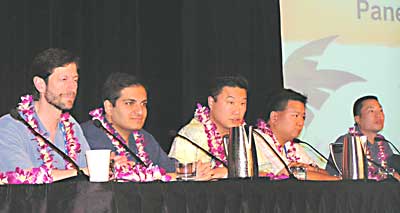Range of severity of IFIS requires varied management strategies
Surgeons detail advances in ophthalmic surgery and complication prevention.

KOLOA, U.S.A. – Because the severity of intraoperative floppy iris syndrome can vary significantly between patients and even between two eyes of the same patient, cataract surgeons need a variety of tools to handle any scenario, according to David F. Chang, MD.
 David F. Chang |
Speaking here at Hawaiian Eye 2007, Dr. Chang said symptoms of intraoperative floppy iris syndrome (IFIS) can range from mild, marked by good dilation but a slight billowing, moderate, marked by some tendency for iris prolapse and some pupillary constriction, to severe, categorized by classic triad and poor preoperative dilation.
Surgeons should determine a patient’s history of alpha-blockers in order to know which strategy should be employed, either alone or in combination, said Dr. Chang, an OSN U.S. Edition Cataract Surgery Section Member.
In mild to moderate cases, Dr. Chang said he takes an adjunctive pharmacologic approach. Intracameral alpha agonists, such as phenylephrine and epinephrine can be effective in adding “greater tone to the iris dilator smooth muscle, resulting in a more rigid iris,” Dr. Chang said.
“It makes the iris very rigid and prevents the billowing you would normally see when the [viscoelastic] is removed,” he said. “It’s a wonderful adjunct for any small pupil case.”
He cautioned that only unpreserved solutions should be used, and that mixtures should be diluted to buffer the pH level.
Dr. Chang also discussed iris retractors as a “100% reliable” strategy for pupil expansion in IFIS patients.
“For very severe cases there is nothing like iris retractors,” he said.
The hook is placed subincisionally to retract the iris downward and away from the phaco tip, “giving great chopping exposure.” He added that he uses 4-0 polypropylene retractors from Katena, which he said are easy to manipulate. They are also cost-effective because they can be repeatedly autoclaved.
The following are other highlights from the Hawaiian Eye 2007 meeting including Subspecialty Saturday. Most of these items appeared first as daily coverage on OSNSuperSite.com and in the onsite daily publication, Hawaiian Eye Daily News.
Zigzag-pattern PK
Early results of zigzag-pattern penetrating keratoplasty performed with a femtosecond laser show the procedure to improve postoperative outcomes, according to a presenter here.
|
Image: Mullin D, OSN |
The zigzag configuration, which can only be made with a femtosecond laser, “is biomechanically stable and secure and surgically straightforward,” said Roger F. Steinert, MD, at the Subspecialty Saturday meeting. “The advantage of the zigzag PK is that the watertight seal gives a smooth transition,” he said.
Dr. Steinert performed the zigzag PK procedure on 16 eyes with up to 9 months’ follow-up with the IntraLase femtosecond laser (Intralase Corp.). He performed a 0.5-mm lamellar ring cut at a depth of 320 µm, with 45° angles and 24-bite 10-0 nylon running suture closure.
Topography showed that at 3 months, six out of eight eyes were at or less than the 3.5 D SimK mean. Four out of five eyes showed a best corrected visual acuity of 20/40 to 20/80. Dr. Steinert noted that typically with conventional PK it takes 6 months to regain functional vision and with Descemet-stripping lamellar endokeratoplasty it normally takes 3 months.
Postoperative evaluation with the Visante OCT (Carl Zeiss Meditec) “shows strong healing, and it shows that at 3 months there is a greater signal at the wound, which may correlate with wound healing,” Dr. Steinert said.
He said he is working with Carl Zeiss Meditec, maker of the Visante OCT, to digitize the image to verify if this is quantifiably indicative of wound healing.
He also noted that the OCT image indicated that the procedure is an improvement over conventional methods.
Be alert to avoid TASS
The incidence of toxic anterior segment syndrome is low – estimated at around 0.1% to 2% – but “it appears to be growing,” according to surgeon speaking here.
In light of this, Terry Kim, MD, said the surgeon is the key to recognizing the problem immediately and alerting the appropriate staff or other centers to take swift action.
Toxic anterior segment syndrome (TASS) occurs in clusters or outbreaks, so it could indicate that something has changed in the office setting that might be provoking it.
“You may have some change in your sterilization protocol that you might not even be aware of,” Dr. Kim said. “It is certainly an environmental and toxic control issue, and it does require an investigation and a complete analysis.”
He urged surgeons to pay close attention to any medication they inject into the anterior chamber and to be attuned to any changes in operating and sterilization protocol.
“But you are the key in identifying any epidemic of TASS, because you’ll be seeing these patients postoperatively,” Dr. Kim said.
Surgeons should take prophylactic measures to ensure that TASS and other infections do not enter the eye peri- or postoperatively.
Alternative ways to seal wounds to help bacteria and organisms from entering the eye are also becoming available, Dr. Kim said. A new liquid sealant called OcuSeal, a synthetic hydrogel bandage developed by Hyperbranch, is designed for direct application on the ocular surface to protect the wound.
“This might indicate a paradigm shift, moving away from sutures to alternative modes for sealing wounds,” he said.
Supracapsular phaco an option for refractive lens surgery
Supracapsular phacoemulsification is particularly suited to refractive cataract surgery, which is often done in softer nuclei, said Richard L. Lindstrom, MD, Hawaiian Eye 2007 meeting co-program chair and OSN Global Chief Medical Editor.
Dr. Lindstrom said the supracapsular phacoemulsification technique is safe and fast, particularly for softer lenses. In addition, because the nucleus is brought anteriorly, above the iris plane, this technique is well- suited for floppy iris syndrome, as the nucleus will hold the iris down during phacoemulsification. And because the phacoemulsification is performed more anterior, there is greater distance from the posterior capsule, which may translate to an increased safety margin for the prevention of capsular breaks and vitreous prolapse, he said.
The technique involves performing a sufficiently large capsulorrhexis, at least 5 mm in diameter, followed by significant hydrodissection. Dr. Lindstrom performs the hydrodissection in a controlled, pulsatile manner in order to prolapse the nucleus out of the capsular bag. Once the nucleus is partially tilted out of the capsular bag, the nucleus can be further prolapsed by injecting viscoelastic behind it.
The 30° phaco tip is placed bevel down to direct the ultrasound energy into the cataract and away from the corneal endothelium. Dr. Lindstrom employs higher vacuum for this technique, using 300 mm Hg to 400 mm Hg for a venturi pump and 400 mm Hg to 600 mm Hg for a peristaltic pump. Although a moderate to high flow rate is used for the infusion, a flow restrictor is used on the outflow tubing to maintain a stable anterior chamber.
At the end of the case, hydration of both the primary clear corneal incision as well as the paracentesis is performed in order to ensure a watertight eye. Standard postoperative topical mediations include a fluoroquinolone, a corticosteroid, and a nonsteroidal anti-inflammatory drug, he said.
Detecting optic nerve variation essential in glaucoma
A careful evaluation of the optic nerve is “indispensable” to early detection of glaucoma, according to Jody R. Piltz-Seymour, MD, who described various factors glaucoma specialists should consider in their evaluation of the optic nerve and explained why she feels this is critical.
“You can have glaucoma diagnosed and followed well before visual field loss is detected, so a careful evaluation of the optic nerve is indispensable,” said Dr. Piltz-Seymour. “Imaging has revolutionized following the progression of glaucoma and helping in its diagnosis, but nothing replaces looking carefully at the optic nerve,” she said.
When it comes to looking for optic nerve irregularities, Dr. Piltz-Seymour said “the more you look, the more you’ll see.”
She advised attendees to use stereopsis and magnification when possible; to look for contour changes in both color and shape; and compare the eye to a normal optic nerve as well as to the contralateral eye.
Use the acronym SHIP to remember the four elements to evaluate, she said. These include size, hemorrhage, the “ISN’T” rule and peripapillary atrophy. The ISN’T rule refers to the inferior, superior, nasal and temporal thickness of the neural retinal rim, Dr. Piltz-Seymour said. She also stressed that size is important when it comes to optic nerve evaluation.
|
Image: Wolkoff L, OSN |
Surgeon: Take precautions to prevent endophthalmitis
A comprehensive drug regimen and meticulous surgical steps are key to endophthalmitis prevention in cataract surgery, said Roger F. Steinert, MD, in discussing his preoperative, intraoperative and postoperative steps for infection prevention.
Preoperatively, Dr. Steinert said he first treats chronic meibomian gland disease in blepharitis. He also tells his patients to stop wearing cosmetics.
“We used to use antibiotic skin cleanser,” he said, but that has fallen out of practice. “Perhaps it is time to revisit that.”
Dr. Steinert also prescribes currently available fluoroquinolones, either Zymar (gatifloxacin 0.3%, Allergan) or Vigamox (moxifloxacin 0.5%, Alcon) four times a day, 1 to 3 days preop.
On the day of surgery, Dr. Steinert gives his patients antibiotic drops immediately upon their arrival in the preoperative area.
“You need to give antibiotic drops at least 30 minutes prior to surgery,” he said.
In the operating room before surgery, Dr. Steinert said he makes sure that his assistants use proper technique in preparing the skin and eyelashes, which is to stroke from the center to the periphery without return.
“Five percent betadine is a good thing applied to the globe but do not use lidocaine jelly before the betadine,” he said.
Next cover and isolate the lashes and meibomian glands with an incision drape. Before the incision, copiously irrigate the surgical field.
Dr. Steinert said there is still debate over clear corneal incisions.
“The only thing we can say with certainty is that not all incisions are created equally,” he said.
There are also a number of issues with intraoperative antibiotics, including the debate over the ESCRS cefuroxime study. He noted that there will be a special session about the study at this year’s ASCRS meeting.
After the incision closure, Dr. Steinert recommends meticulous testing for a watertight seal using fluorescein and observation of both the main incision and the paracentesis.
“When in doubt, suture,” he said.
Postoperatively, Dr. Steinert starts his patients on a fluoroquinolones as soon as possible on the day of surgery. He said there is no evidence regarding dosing frequency and duration, but fluoroquinolones are commonly prescribed four times daily for 5 to 7 days.
“The only strong evidence is for topical betadine antisepsis at the time of surgery,” Dr. Steinert added.
“Draping to isolate the lashes and meibomian glands follows sound surgical principles,” he said.
This will help eliminate the corners that are often cut and undermine your defense, Dr. Maloney said.
Examples of cutting corners are not retaining an expert witness or defense strategy early enough in the process, not prepping witnesses for their depositions and testimony, and not pursuing leads or witnesses who will undercut plaintiffs’ claims.


